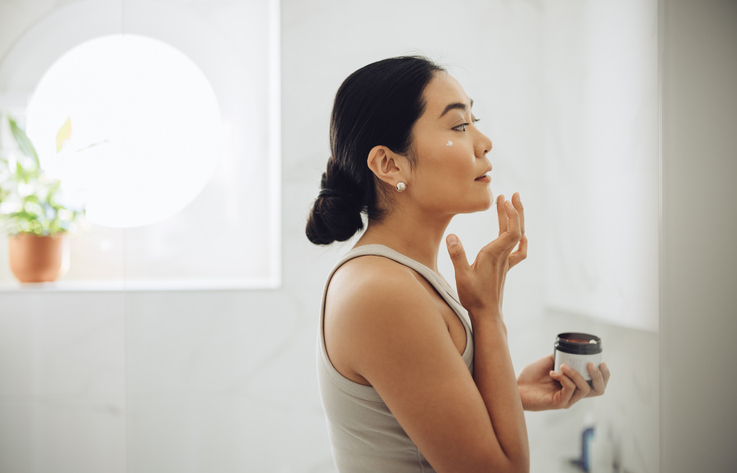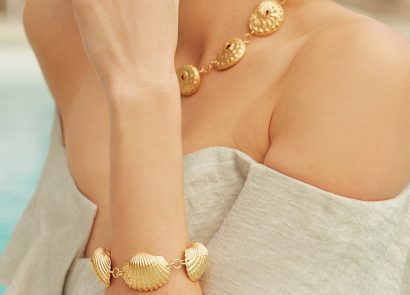Strawberries and cream, gin and tonic, Ant and Dec – some things are just better together. And that is also true when it comes to skincare. As well as products to pair together, there are certain ingredients to look out for that, when used in combination, become greater than the sum of their parts. Complicated product layering routines aren’t for everyone (and who has the time?) but with a bit of insider knowhow, it’s easy to power up your beauty routine with some carefully chosen ingredients to suit your skin. Meet the skincare ingredient power couples that support each other to create the most impressive results.
SPF + Vitamins C and E
Exposure to the sun’s harmful rays can show up on your skin in the form of sunspots, freckles and hyperpigmentation, as well as lines and wrinkles. The bad news is that this damage can lie underneath the skin and not come out until further down the line. The good news? Vitamin C can prevent these signs of sun damage thanks to its depigmenting prowess; and sunscreen is your best friend when it comes to warding off premature ageing. Combining the two (plus vitamin E) equals supercharged protection. “Research has shown that when paired, vitamin C boosts protection provided by SPF, while vitamin E is probably the most important antioxidant for the skin,” says Dr Miriam Adebibe, co-founder of Victor & Garth skin clinic (victorandgarth. co.uk). “Vitamin E absorbs the energy from UV light, helps to strengthen the skin barrier, shields skin from free radicals and protects against long term sun damage,” explains Dr Miriam.
What makes this combination so effective? “When vitamins E and C are combined, they are more effective than either vitamin alone at preventing photodamage, and provide the skin with a double dose of antioxidant ammunition,” says founder of Root + Fruit by Wild Science Lab, Zoe Wasfy. Vitamin E helps to strengthen the skin barrier and shield skin from free radicals, and is also very moisturising.
Try this
To protect the skin from the damaging effects of UV, including hyperpigmentation and inflammation, Bright Start SPF 30 Broad Spectrum UV Shield (£39, wildsciencelab.com) is loaded with vitamins C and E, to protect and help neutralise the damaging effects of environmental skin stress. For best results, apply each morning as the final step in your skincare routine.
Cleanser + Mask
It’s a cardinal beauty sin to apply a face mask without making sure you’ve thoroughly cleansed your skin first. You wouldn’t eat dessert before your starter now, would you? It’s particularly important to clean away make-up and impurities at the end of the day, and after a workout. “You need to wash your face immediately after a workout as allowing the sweat to remain on the skin for a long period of time often shifts the balance of the skin microbiome and can allow fungal and bacterial overgrowth,” explains Dr Sonia, dermatologist and skincare expert for Faace. “Also, while perspiration during exercise helps to cool your skin down, it has the potential to dry it out through the loss of fluids and the sodium in sweat can sting and irritate your skin. Eczema can also be exacerbated by sweat which affects the skin barrier and can worsen itching.”
Try this
Faace’s Workout Wonders Kit (£40, wearefaace.com) contains a potent skincare duo that’s perfect for keeping your skin in shape, post-gym. It contains Dirty Faace cleansing wash to clear skin of sweat and other nasties. Following this, apply the Sweaty Faace leave-on mask, which you can leave on as an overnight treatment, or even use as a primer under make-up. Ingredient-wise, both products contain aloe vera to calm, soothe, and hydrate, plus glycerin, which attracts water and holds it in the skin, leaving it feeling and looking smooth and supple. “These ingredients work really well together and are tolerated by most skin types,” says Dr Sonia.
Exfoliant + Moisturiser
Achieving a smooth surface on your face is a trusted route to a fresh, glowing complexion. Exfoliators generally fall into two camps: chemical and physical. “Chemical exfoliators (like AHAs and BHAs) use ingredients that chemically dissolve the ‘glue’ that holds dead and damaged skin cells together, allowing them to be easily lifted away,” explains Q+A’s product development chemist and skincare expert Faye Purcell. “Alpha-hydroxy acids are more commonly associated with surfacelevel exfoliation, as they help to even out fine lines, brighten skin tone, and generally smooth skin. They are water-soluble, which helps increase our moisture levels, making them a good choice for dry and stressed skin. AHAs include glycolic acid, lactic acid, and malic acid.” These exfoliating acids are usually applied like a toner.
“BHAs, or beta-hydroxy acids, are oil-soluble, meaning they can penetrate deeper into our skin, helping with blemishes by absorbing into our pores,” says Faye. “Salicylic acid is a popular BHA, loved for its ability to fight breakouts and rebalance oily skin while azelaic acid is a bit of an unsung hero.”
Then there are the physical exfoliators, which contain tiny particles to buff skin’s surface – but choose wisely to avoid any damage. “Any particle with a rough and uneven edge, (like a grain of sugar or pulverised walnut shell) can do more harm than good to your complexion. Crystalline ingredients have jagged edges which can cause tiny tears on the skin known as microabrasions, ultimately leading to broken capillaries, redness and irritation. These tears allow bacteria in, which can result in breakouts and acne flare ups,” warns Faye. “Thankfully, we now have particles like jojoba beads to make physical exfoliation safe for our skin again. Jojoba esters, like those found in our Niacinamide Gentle Exfoliating Cleanser, consist of a complex mixture of natural, long chain fatty acids. Their spherical shape provides the same gentle exfoliation as a microbead to gently lift away dead skin cells and impurities and as they are biodegradable, it makes them both environmentally friendly and safe for all skin types.”
Post-exfoliation is the ideal time to moisturise. Once the dead cells on the outer layer of your skin have been removed, your serums and creams can penetrate more deeply rather than simply sitting on the surface, helping you get your glow on.
Try this
The Q+A Glycolic Acid Daily Toner (£8, qandaskin.com) helps brighten and hydrate, as well as reduce pores, blemishes and hyperpigmentation all in one easy swipe. “Glycolic acid is a very effective AHA. It has the smallest molecular weight of all AHAs so it penetrates the deepest and can build collagen in addition to improving tone and texture,” Faye tells us. It also contains hyaluronic acid, which gently hydrates and helps to ward off those pesky fine lines.





















